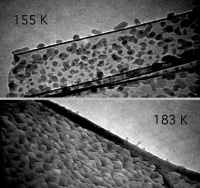We found evidence that water in the cubic domain shows bulk motion.

We found that the ice film on the hydrophobic amorphous carbon substrate tends to form droplets as soon as the water film is warmed above the glass transition temperature T = 120-140 K.
Those droplets seem to "melt" when the temperature is raised above 170 K in a 1 K/min warmup. At 185 K, the landscape looks different than at 150 K.
The changing morphology occurs when the viscosity of the material has decreased to the extend where the surface free energy with the amorphous carbon substrate has become low enough to not drive minimisation of the surface area.
Last modified: July 7, 1997
P. Jenniskens
D.F. Blake